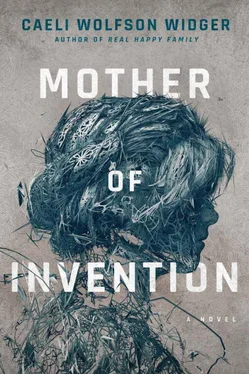Caeli Wolfson Widger
MOTHER OF INVENTION
For my mother, Cathy Schwarzkopf Wolfson, who knew me first.
When provided with every practical support option and no logistical restraints, women may inhabit motherhood wholly, but without compromising their relationship to their work or themselves.
—Tessa Callahan,
The Seahorse Solution: A New Approach to Motherhood
2021
On day one of the Seahorse Trial, Tessa Callahan awoke at 4:45 a.m., eased into consciousness by the dawnlike glow of the KindClock on the nightstand. Her husband, Peter, slept on his back beside her, wearing only plaid boxers, his rib cage rising and falling in slow measure. Outside, it was dark, the streetlamps of Atherton still haloing the sidewalks, dew just beginning to form on the wide lawns of houses as perfect as designer cakes. Tessa’s own was a five-bedroom Georgian neoclassical, which she’d purchased and renovated four years ago, after Loop Industries had gone public and made her rich. She’d married Peter that year also, the year they’d both turned forty, and they’d turned the property into a suburban oasis: two gardens—succulent and vegetable—infinity pool, guesthouse/“Zen den” in the backyard.
Peter had trepidation about living so well—he’d been in a railroad apartment in the Mission District of San Francisco since finishing grad school and was a minimalist by nature—but Tessa was unconflicted. She’d worked hard, harder than most people she knew, even here in Silicon Valley, where a forty-hour workweek was considered part-time. She’d put herself through business school without racking up a cent of debt; founded two hit biotech startups, both of which had released products that improved the world; and was currently running a third—Seahorse Solutions, her most ambitious project yet. Part of Tessa’s stock portfolio went to cause-based investing. She gave generously to charity, ate low on the food chain, volunteered at a nonprofit that taught young girls to write software code. She’d earned her life.
Tessa sat in bed and raked her fingers through her “new” hair, which her stylist had recently transformed from the blunt bob Tessa had worn since college into a cap of choppy layers. The stylist had also insisted on lightening Tessa’s natural auburn locks to a blonder, “more approachable” shade. The change somehow made Tessa feel both younger and more authoritative. It also showed off the aloe green of her eyes and her good skin, which was still relatively porcelain, while minimizing what her stylist referred to as Tessa’s “strong nose.” Ever since Tessa’s PR people had assigned her a RAW (relatability, accessibility, warmth) quotient of four out of ten, every one of her handlers seemed hell-bent on raising her score.
Secretly, Tessa was proud of her RAW number. It aligned with the ideas she’d promoted in her book, Pushing Through: A Handbook for Young Women in the New World . Don’t be pleasers, she instructed her readers. Embrace your unlikability. Practice confrontation. Banish your guilt. (She’d even banished it from her book itself, referring to it only as the g-word .) Her imperatives resonated intensely with young women all over the country and the world; Pushing Through was an instant bestseller and went on to spend thirty weeks on the New York Times list.
Across the bed, Peter moaned softly in his sleep and shifted from his back to his side. Their golden retriever, Python, raised his head from his fleece-covered bed on the floor and stretched his nose up toward Peter. Then he tucked it back down by his tail and returned to sleep. Animals loved Peter; he and Python had a near-telepathic connection. Python had been Tessa’s when she and Peter met, but now she could hardly remember the last time she’d taken the dog on a walk. He was completely devoted to Peter, in a manner so pure it made Tessa reflect on her own devotion. She knew how much she loved Peter, but did she show it enough? Did he have enough evidence to believe her?
It had been so easy in the beginning. He’d been her coach in preparation for the annual Tech Tread in San Francisco, a charitable fundraiser in the form of a swim race in the Bay. Historically, all the big Silicon Valley execs participated, and hordes of spectators turned up to watch the well-known billionaires compete against each other in the frigid water. Tessa was a weak swimmer and had never participated, but the year after Sheryl Sandberg won the race, beating a field of mostly younger men, Tessa felt compelled to sign up, to the delight of her PR team. To help her prep, they’d hired Peter Grandwein, a longtime member of the local Polar Bear Club with a great reputation for teaching open-water swimming to beginners.
Swimming in the Bay, it turned out, even sealed in a wetsuit, terrified Tessa. The water was freezing and opaque, and absurdly, she could not stop thinking about old photos of the Loch Ness monster that had thrilled her as a child. When she looked out to the Alcatraz and Farallon Islands and imagined being alone in the water, far from shore, her heart beat so fast she felt she might hyperventilate.
Peter never told her not to be afraid. He never dismissed her panic. Instead, he suggested she visualize the water holding her up. To pretend she was a part of it. To give herself over to it and trust her body. He was so supportive, so kind, so nonjudgmental, and so totally in control. Swimming lessons were one of the rare times Tessa felt vulnerable and actually enjoyed it. They were a reprieve from her life on land, where she was perpetually managing, controlling, fixing. Also, Peter was so different from the men Tessa worked with, with their laid-back demeanors and little-boy clothes. Her colleagues in Silicon Valley were approachable in appearance but actually entrenched in an airtight boys’ club. They were men who said one thing and meant another, who played video games with the exuberance of teenagers. Men who’d been labeled brogrammers or boy-kings . Men like her co-CEO at Seahorse Solutions, Luke Zimmerman.
Peter was nothing like Luke or the rest of them. Where they were cagey, Peter was straightforward. What Tessa disliked about the men in tech was the disparity between the lassitude of their surfaces and the cutthroat ambition underneath. No one got that rich by accident.
After one swim lesson, she hadn’t been able to get Peter out of her mind: the clean angles of his jawline, the haze of stubble across his face, how his brown eyes held hers and didn’t let go as he talked about bilateral breathing, head turns, stroke angles. She nodded and did her best to imitate him, noting the broadness of his shoulders as he told her to think of herself as part of the water, as in sync with the Bay.
After four lessons, she was beginning to swim with confidence, completing the half-mile swim from the dock to the buoys and back in faster and faster times. She hit her goal of completing the route in under thirty minutes, and instead of issuing his usual high five, Peter pulled her into a hug. They stood together on the dock, Tessa shivering against him, her heart at a gallop, her mind finally, truly devoid of thoughts. All that existed was Peter’s body against hers.
After her fifth and final swim lesson, the idea of never seeing him again seemed tragic.
She asked him to dinner. Two nights later, after work on a Friday, Tessa met him at his favorite taqueria in the Mission.
Читать дальше













